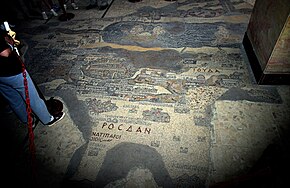Mamre

The Constantinian church at Mamre appears on the Madaba Map (right margin, adjacent to the modern pillar)
|
|
| Alternate name | Ramat el-Khalil (Rāmet el-Ḥalīl) |
|---|---|
| Location | Judea, West Bank |
| Coordinates | 31°33′24″N 35°06′19″E / 31.556536°N 35.105336°E |
| History | |
| Founded | 9th-8th century BCE, Kingdom of Judah; 1st century BCE, Herod the Great; 130 CE, Emperor Hadrian; 324 CE, Constantine the Great; 12th century, Crusaders |
| Site notes | |
| Archaeologists | Andreas Evaristus Mader (1926-1928), Sayf al-Din Haddad (1977), 'Abd el-Aziz Arjub (1984-85), Yitzhak Magen (1986-88) |
Mamre (/ˈmæmri/; Hebrew: מַמְרֵא), full Hebrew name Elonei Mamre ("Oaks/Terebinths of Mamre"), refers to an ancient cultic shrine originally focused on a single holy tree, belonging to Canaan,Talmudic sources refer to the site as Beth Ilanim or Botnah, where it was one of the three most important "fairs", or market places, in Judea. Mamre lies approximately halfway between Halhul and historical Hebron, 4 kilometres north of the latter.
Genesis 13:18 has Abraham settling by 'the great trees of Mamre'. The original Hebrew tradition appears, to judge from a textual variation conserved in the Septuagint, to have referred to a single great oak tree, which Josephus called Ogyges. Mamre may have been an Amorite, a tribal chieftain after whom a grove of trees was named. Genesis connected it with Hebron or a place nearby that city. Mamre has frequently been associated with the Cave of the Patriarchs. According to one scholar, there is considerable confusion in the Biblical narrative concerning not only Mamre, but also Machpelah, Hebron and Kiryat Arba, all four of which are aligned repeatedly. In Genesis, Mamre is also identified with Hebron itself. The tradition of identifying the unwalled ruins of what Arabic tradition records called Rāmet el-Ḥalīl (Hill of the Friend), with the Old Testament Mamre goes back to the earliest Christian pilgrims in the 4th century CE.
...
Wikipedia

